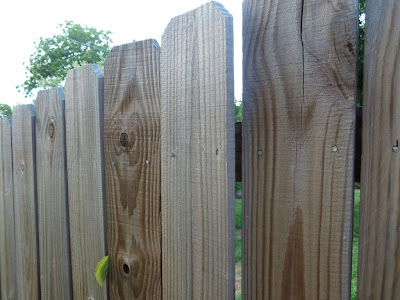One rather curious feature of our house, at least for me, is the presence of a fence around the back yard. When I was growing up we lived on a corner lot with nary a fence in sight, and the boundaries between our yard, the alley, the boulevard, and the neighbor's yard were blurry at best. There was a fence, come to think of it, but it was obscured by a line of evergreen trees so we just didn't think about it that much. It was a nice environment in which to grow up, and helped to ensure that in our many games of kickball and soccer the fields were not limited by a wooden or metal line. In our current location things are a bit different, but not necessarily in a bad way. Even though the back yard is fenced in, it actually works quite well since the back yard isn't all that big to begin with. It's kind of long and triangular shaped, and due to the presence of a large Chinese Pistache tree would not lend itself to many backyard sports at all. But we enjoy it quite a bit, and since our front yard is much bigger and lacks any sort of fence, it does well when playing host to outdoor sports and games.
One thing about the fence though, is it does require some degree of maintenance and upkeep. Case in point: the boards have a tendency to come loose like so:
 |
| Boards on a fence: good. Boards affixed with nails: not that good. |
I've gone out and pounded the nails in from time to time, but found that what works best is to replace the nails with high-quality wood screws. A few days ago I went and took care of a couple loose boards again, with these trusty little fellers:
 |
| 4 volts of SHEER POWER!!! |
The screw gun is a fantastic little tool my dad gave me about a year ago, and even though it's small and relatively weak compared to its
heavy-duty counterparts, it's great for little jobs around the house (and when it's not, I've got a nice DeWalt drill for the big jobs). It takes almost any bit with a standard hex base, and has adjustable torque settings to make sure you don't screw in anything too tight. The screws I used are exterior wood screws with a torx head, which basically means that instead of a standard
slot- or
philips-head design, they've got a
star pattern. This helps ensure that the bit will not slip off when screwing them in. They're self-boring too, which means that you don't need to pre-drill holes in the wood. The result looked something like this:
 |
| All fixed up and ready to go |
I suppose as the other fence nails work themselves out over time I might just replace everything with wood screws, but that for now this solution works well for the occasional patch-up job.




No comments:
Post a Comment